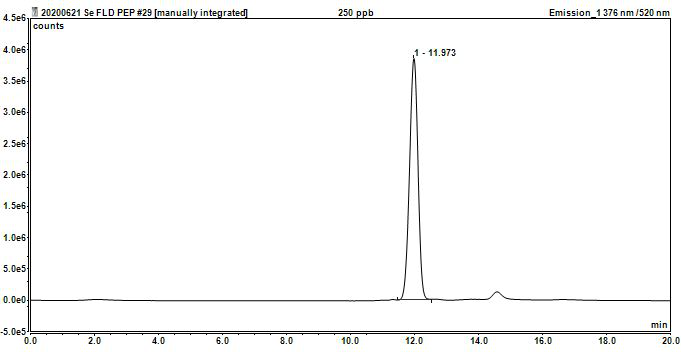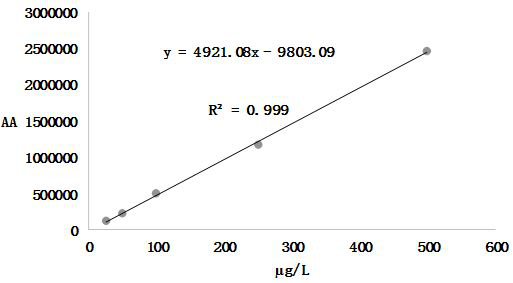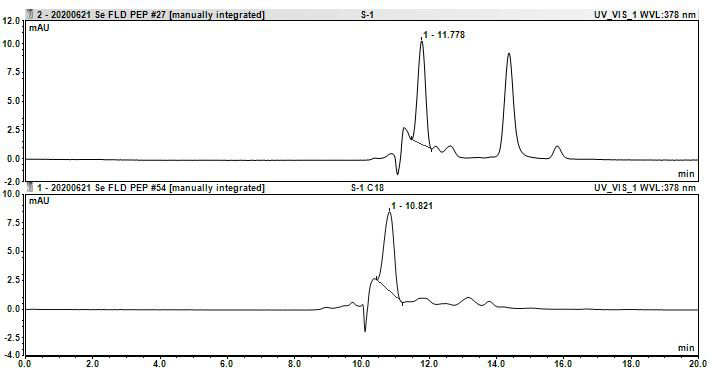Method for determining total selenium content in selenium-rich proteoglycan by high performance liquid chromatography
A high-performance liquid chromatography and selenium-enriched protein technology, which is applied in measuring devices, material excitation analysis, fluorescence/phosphorescence, etc., can solve problems such as loss and ineffective separation of interfering substances, and avoid matrix interference and multiple transfers Effect
- Summary
- Abstract
- Description
- Claims
- Application Information
AI Technical Summary
Problems solved by technology
Method used
Image
Examples
Embodiment 1
[0024] Embodiment 1 The drawing of standard curve
[0025] Accurately weigh 50.0 mg of sodium selenite and dissolve it in 500 mL of 0.1 mol / L HCl, and gradually dilute with 0.1 mol / L HCl to form 500.0, 250.0, 100.0, 50.0 and 25.0 µg / L sodium selenite standard working solutions . After step 0005, use RPHPLC-UV-FLD analysis to determine the content of 4,5-benzokohlrabiselenium.
Embodiment 2
[0026] Example 2 National Standard Method Determination of Total Selenium Content
[0027] Accurately weigh 0.5 g~3 g of sample, add 10 mL of HNO3-HClO4 mixed acid (9+1) to digest overnight. After 12 hours, heat and digest on an electric heating plate until the remaining volume is about 2 mL. After cooling, add 5 mL of hydrochloric acid solution (6 mol / L), and continue heating until the remaining volume is about 2 mL. After cooling, dilute to 100 mL with water, measure part of the solution (pH 1.5-2.0, Se content ≤0.4 µg), add 3 mL of hydroxylamine hydrochloride and 2 mL of DAN, shake well, and place in a boiling water bath for 5 min. After cooling, it was extracted with 10 mL cyclohexane, and the fluorescence intensity was measured with a fluorescence photometer under the condition of excitation wavelength of 376 nm and emission wavelength of 520 nm, so as to calculate the selenium content in the sample.
Embodiment 3
[0028] Determination of total selenium content in embodiment 3 seleno-enriched proteoglycans
[0029] Weigh 25 mg selenoproteoglycan sample, add 10 mL HNO 3 -HClO 4 Mixed acid (9ml HNO 3 and 1ml HClO 4 ) for cold digestion overnight; after 12 hours, heat and digest on an electric heating plate to a remaining volume of 2 mL, then add 5 mL of hydrochloric acid solution (6 mol / L) after cooling, continue heating to a remaining volume of 2 mL, and adjust the pH value to 1.5~ 2.0, and dilute to 250 mL with water, take 3 mL of the sample into a 5 mL stoppered centrifuge tube, add 0.5 mL of DAN to it, react in a boiling water bath for 10 minutes, and after cooling in running water, add 400 μL of acetonitrile to it successively and 120 μL of chlorobenzene, shake for 5 minutes, then stand still for 5 minutes, and finally centrifuge at 5000 rpm / min for 5 minutes; pipette 100 μL of chlorobenzene and add 100 μL of acetonitrile to it, mix well and inject the sample. Separation by PFP c...
PUM
 Login to View More
Login to View More Abstract
Description
Claims
Application Information
 Login to View More
Login to View More - R&D
- Intellectual Property
- Life Sciences
- Materials
- Tech Scout
- Unparalleled Data Quality
- Higher Quality Content
- 60% Fewer Hallucinations
Browse by: Latest US Patents, China's latest patents, Technical Efficacy Thesaurus, Application Domain, Technology Topic, Popular Technical Reports.
© 2025 PatSnap. All rights reserved.Legal|Privacy policy|Modern Slavery Act Transparency Statement|Sitemap|About US| Contact US: help@patsnap.com



